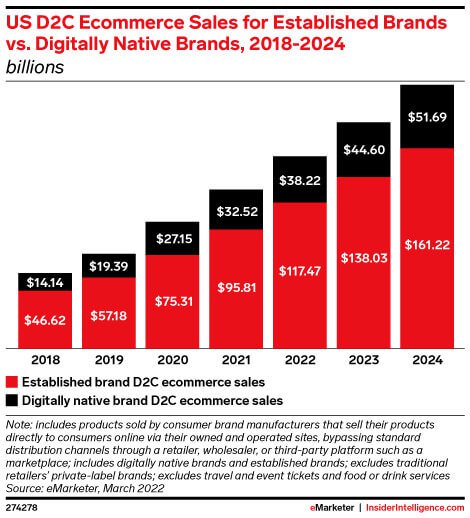Digitally Native Vertical Brands (DNVBs): Everything You Need To Know
Launching an online store? You might want to consider making it a digitally native vertical brand. Here are the pros and cons and what that all means.
Updated November 6, 2024

If you're like pretty much everyone else, you're used to thinking of online retail as a byproduct of brick-and-mortar commerce. For most brands, eCommerce is yet another avenue they can use to sell their products. For digitally native vertical brands (DNVBs), eComm is where it all begins.
The first one, Bonobos, was launched in the US in 2007 by Andy Dunn – and many others followed soon after. While still not the norm in eCommerce, DNVBs are gaining ground and might be an excellent option for many.
It makes sense: with digital channels becoming increasingly more accessible worldwide, it's easier to launch a direct-to-consumer brand without the overhead of a physical store – and then move it into brick-and-mortar territory.
What are digitally native vertical brands, how does the model work, and what are the essentials of growing a digitally native vertical brand?
Let’s dive in.
What is a digitally native vertical brand, and how does the model work?
A digitally native vertical brand (DNVB) is an online business that expands to physical locations. DNVBs will design the products on their own, order them from manufacturers, and sell them directly to consumers, thus bypassing all middlemen and owning the entire process.
Some of the features typical of digitally native brands include:
1. A digital-first approach
Typically, a digitally native vertical brand starts by establishing a solid online presence, leveraging digital marketing strategies and channels to reach and engage with its target audience.
This digital-first approach allows the brand to build a robust online community and establish a direct connection with customers, positioning DNVBs as customer-centric brands where consumers feel listened to, heard, and part of the brand's story.
2. Vertical integration
Vertical integration is another essential aspect of the DNVB model. Unlike traditional retail brands that rely on multiple intermediaries for production and distribution, digital brands often have control over their entire value chain.
This means they can oversee the entire process, from sourcing raw materials to manufacturing and delivering the final product. Vertical integration enables digital brands to maintain quality control, streamline operations, and respond quickly to market demands.
3. Direct-to-consumer (DTC) sales
Direct-to-consumer (DTC) sales form the third pillar of the DNVB model. By cutting out middlemen, digitally native brands can sell their products directly to customers, eliminating the need for retail markups.
This allows DNVBs to offer competitive pricing while maintaining higher profit margins. Additionally, DTC sales enable brands to gather valuable customer data, facilitating personalized eCommerce marketing strategies and enhancing the overall customer experience.
How have DNVB businesses evolved?
Since the emergence of the DNVB model, these businesses have evolved to adapt to changing market dynamics. Initially, digital brands focused on disrupting traditional industries with innovative products and unique value propositions.
However, as the DNVB concept gained popularity, the market became more saturated, necessitating further differentiation.
To stand out from the competition, digital brands have expanded their offerings beyond product-centric approaches. They now prioritize building strong brand identities and creating immersive experiences for customers.
Digitally native vertical brands can forge deeper connections with their target audience and foster long-term loyalty by emphasizing brand values, storytelling, and community engagement.
DNVB vs. DTC: What you need to know
DNVBs and DTC brands share a lot of similarities, but they are not one and the same (at all.) Essentially, DTC (direct-to-consumer) refers to a sales model in which brands sell directly to customers, bypassing traditional retail channels.
On the other hand, DNVBs refer to the broader business model that includes the DTC approach but also incorporates other elements, such as vertical integration and a digital-first strategy.
Essential differences between DNVBs and DTC include:
- Value chain control: digital brands typically have greater control over their entire value chain, including production, distribution, and customer experience. DTC brands primarily focus on cutting out intermediaries in the sales process.
- Branding and storytelling: DNVBs focus a lot on brand identity, storytelling, and community engagement. DTC brands often prioritize convenience and affordability over brand building.
- Product range: digitally native brands often have a narrower product range, focusing on a specific niche market. DTC brands can have a broader product offering, targeting a wider customer base.
- Scalability: DNVBs are designed to scale quickly - and they do this by leveraging digital marketing and operational efficiencies. DTC brands may face scalability challenges when relying on traditional manufacturing and distribution processes.
DNVB vs. eCommerce
When comparing digitally native vertical brands to traditional eCommerce businesses, several key factors differentiate the two models. Understanding these differences can help marketing managers and business owners make informed decisions about their digital marketing strategies.
Growth
Digital brands have the potential for rapid growth due to their digital-first approach and ability to scale quickly. Traditional eCommerce businesses may face more competition and require substantial investment to achieve similar growth rates.
Selling model
DNVBs primarily rely on a direct-to-consumer (DTC) selling model, while eCommerce businesses often operate as marketplaces or rely on third-party sellers.
Branding
Digitally native vertical brands prioritize brand building and storytelling, creating a unique identity to differentiate themselves from competitors. Traditional eCommerce businesses may focus more on product listings and customer reviews.
Target market
DNVBs typically cater to a specific niche market and often have a well-defined target audience. eCommerce businesses may have a broader customer base, catering to a wide range of interests and demographics.
Profitability
Digitally native brands often have higher profit margins due to their control over the value chain and the elimination of retail markups. Due to increased competition and price sensitivity, traditional eCommerce businesses may face lower profit margins.
Advantages of a DNVB business
Building a digitally native vertical brand offers several advantages for marketing managers and business owners. Understanding these advantages can help shape digital marketing strategies and drive business growth.
Direct customer relationship
DNVBs can establish a direct connection with customers, enabling personalized marketing efforts, gathering valuable data, and fostering long-term loyalty.
Control over the value chain
By vertically integrating their operations, digital brands have control over the entire value chain, allowing for streamlined processes, quality control, and quicker response times to market demands.
Brand differentiation
DNVBs prioritize brand building, storytelling, and community engagement, creating a unique identity that resonates with their target audience and sets them apart from competitors.
Agility and scalability
Digitallt native vertical brands can leverage digital marketing strategies and operational efficiencies to scale quickly and adapt to changing market dynamics.
Should you launch a DNVB? Key metrics to consider
Before you venture into the world of digital brands, consider your key metrics -- the numbers you’ll keep an eye on to gauge your DNVB’s success. Here are some performance indicators you might want to look at:
Net customer growth
Your net customer growth measures how much your client base is growing. To calculate it, subtract the customer churn rate from the total customer acquisition rate. Doing it allows you to determine your business’ trajectory, your products’ market acceptance, and make smart decisions about your business's future (such as whether to invest more in marketing or customer retention.)
Projected lifetime value
If you want to allocate your budget effectively and plan your resources to maximize your return on investment, you need to calculate your projected lifetime value. To do this as accurately as possible, remember to factor in the expected customer lifetime, purchase frequency, average order value, and estimated gross margin.
Customer acquisition cost (CAC)
Your customer acquisition cost estimates how much money you need to invest to acquire a new customer. This metric will help you assess your marketing strategies' efficiency and your business model's sustainability.
To calculate your CAC, divide the total marketing cost over a given period by the number of customers acquired in that timespan.
Contribution margin
If you want to evaluate the profitability of your product or service (considering both direct and indirect costs), you need to calculate the contribution margin. To do this, subtract variable costs from the selling price of a product or service.
Total addressable market
Assessing the size of the potential market helps you determine the scalability and growth potential of the business. To calculate the total addressable market, you must factor in the customer base, purchase behavior, and competitor analysis.
How to build a successful DNVB?
Building successful digitally native brands requires a strategic approach around community engagement, performance marketing, and predictive analytics.
Focusing on community engagement
Cultivating a strong community around the brand fosters loyalty and word-of-mouth marketing. Engaging with customers through social media, online forums, and events helps build brand advocates and drives customer acquisition.
To build a strong community, you must ensure your customer service, product, sales, and marketing teams are all fully aligned from every perspective. Allowing information to flow freely between different teams enables you to connect to consumers and respond to their feedback.
Running performance marketing
Leveraging data-driven performance marketing strategies allows digital brands to reach the right audience at the right time. Utilizing digital advertising platforms, search engine optimization, and email marketing can help drive targeted traffic and conversions.
Some performance marketing channels that drive online sales include social media ads, Google Ads (both Search and Display), affiliate marketing, and video ads (on YouTube, TikTok, etc.).
Using predictive analytics
Harnessing the power of predictive analytics helps optimize marketing efforts, understand customer behavior, and forecast future trends. Digital brands can make informed decisions and tailor marketing strategies to maximize results by analyzing data patterns and customer insights.
Predictive analytics comes in many shapes and forms, but some of the ones more commonly used in eCommerce include:
Recommendation engines
These tools use collaborative filtering and content-based filtering approaches to provide personalized product recommendations to customers based on their past purchases, product metadata, and user profile data. They tailor the shopping experience and establish meaningful customer relationships.
Landing page optimization tools
This tool suggests the best product or service offerings to customers as soon as they open an online store, focusing on presenting the most valued products first to increase engagement and conversions.
Advanced analytics
Augmented analytic platforms analyze structured and unstructured data from various sources, enabling advanced levels of personalization across sales channels. They require robust data analytics foundations and integration with customer data platforms.
Demand prediction
ML-powered predictive analytics models are used to forecast demand, considering historical data, price fluctuations, promotions, weather conditions, and other factors. These models help ensure adequate stock availability and can even enable automatic replenishment.
The nuances of selling long-tail products
Predictive analytics platforms need to account for low-selling products with limited data. The models should minimize factors that influence predictions, analyze data from external sources to detect demand patterns, and involve human judgment in demand planning initiatives.
Dynamic pricing
Predictive analytics and machine learning are used to dynamically adjust prices based on historical data, supply and demand, market trends, competitors' prices, and consumer habits. Dynamic pricing strategies help respond to demand fluctuations, attract customers, and increase profits.
Looking for more tools to help you grow your eCommerce business? Check out our list of 40+ eCommerce tools you can leverage to attract and convert your target audience.
Is the DNVB model right for your business?
Digitally native vertical brands are an exceptional niche in eCommerce. These digital brands are built in pixels (rather than physical avenues), focus on online marketing techniques, and bypass supply chains and traditional eCommerce logistics – all so they can ship great products with customer loyalty and community as their North Star.
Are digitally native brands better than traditional brands?
It's not a given. Many traditional brands are equally as focused on their customers – but if you are looking for a way to bypass the hurdles of brick-and-mortar stores and physical retail locations, have complete control over your supply chain, and build a brand that speaks to your audience, a digital brand might just be what you need.
FAQs
What are digitally native companies?
Digitally-native businesses sell their products or services often entirely online. Instead of investing in physical locations as touchpoints with customers, digital natives invest in creating the best digital customer experience. Using the pools of data available from each customer journey, whether it ends with a click on the glorious confirmation button, a pitiful abandoned cart, or anything in between, sales and marketing efforts can be tailored to customers' behaviors, needs, and desires. Common examples of what digital natives can do include expanding product lines or adding tiers to a subscription service.
What is the difference between DTC and DNVB?
DTCs and DNVBs represent two different concepts in e-Commerce. DNVB (digitally native brand) is a business model, while DTC (direct-to-consumer) is a sales model. All DNVBs sell direct to consumers, but not all DTC eCommerce businesses are digitally native.
What is a vertical brand name?
Vertical brands set themselves apart by claiming that they are "better" than their competition by relevant objective measures. Hyundai's claim that their IONIQ hybrid cars are "the most fuel-efficient cars in America" with the numbers to prove it, or smartphones known for their powerful cameras, are just a couple of popular examples. While this can have clear advantages, maintaining a vertical brand name invites fierce competition, and requires constant upgrades to maintain a competitive edge.
What is a digitally native vertical brands list?
Some of the most popular digitally native vertical brands include Allbirds, Bonobos, Warby Parker, Dollar Shave Club, and Glossier. These businesses sell their products or services almost exclusively online and have managed to build up a reputation for quality products and high customer satisfaction.



![[Interview] Shama Hyder on the Biggest Mistakes eCommerce Brands Make with PR](https://entail.mayple.com/en-assets/mayple/fit-in/280x280/61b21c7aa9ad4a8e9cb6a3a8_shamahyderinterviewmayple_1d59e4bf94d80a4f530b57f6f9bd5842_2000-1699776086626.png)

